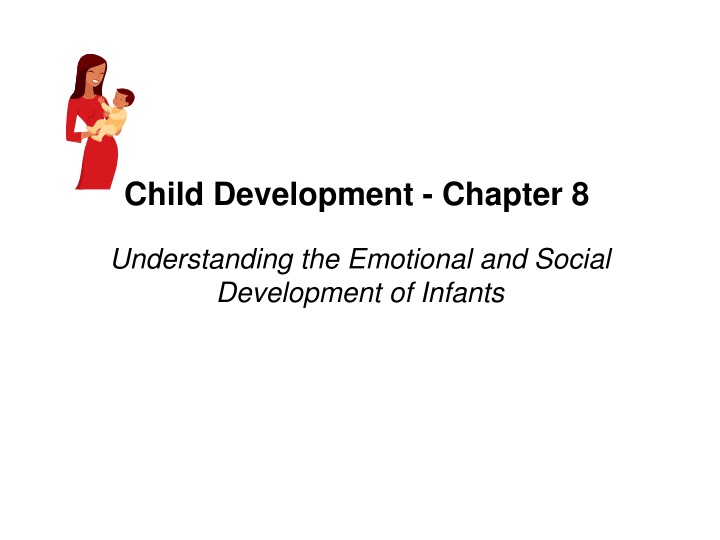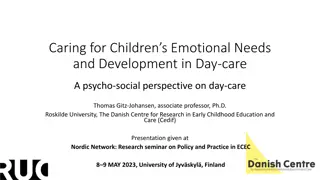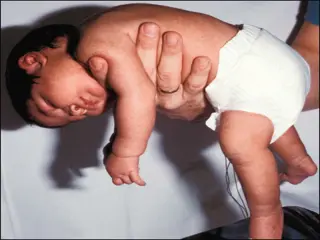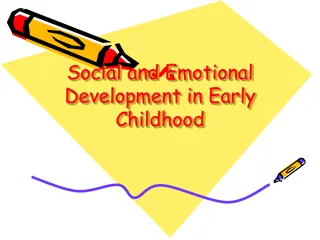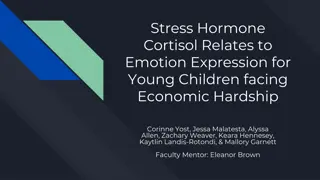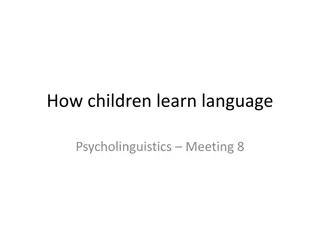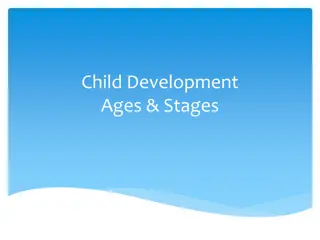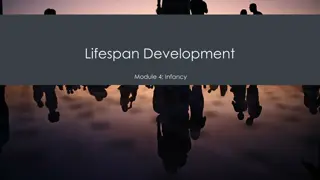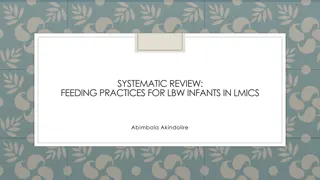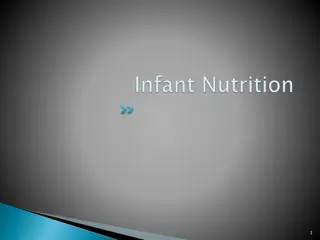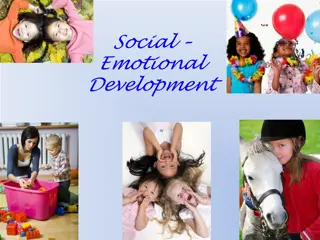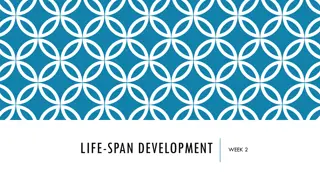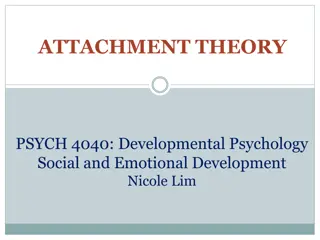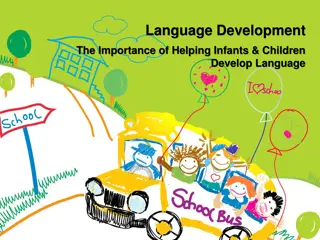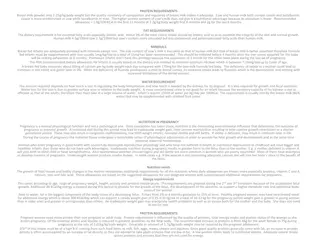Emotional and Social Development of Infants
Emotional development involves recognizing and expressing feelings, while social development focuses on interacting with others. Infants display emotions like pain, contentment, delight, interest, disgust, joy, sadness, and anger. Attachment, as seen in the bond between child and caregiver, is crucial for building trust. Communication through vocal sounds, facial expressions, eye contact, and touch helps fulfill infants' emotional and physical needs.
Download Presentation

Please find below an Image/Link to download the presentation.
The content on the website is provided AS IS for your information and personal use only. It may not be sold, licensed, or shared on other websites without obtaining consent from the author.If you encounter any issues during the download, it is possible that the publisher has removed the file from their server.
You are allowed to download the files provided on this website for personal or commercial use, subject to the condition that they are used lawfully. All files are the property of their respective owners.
The content on the website is provided AS IS for your information and personal use only. It may not be sold, licensed, or shared on other websites without obtaining consent from the author.
E N D
Presentation Transcript
Child Development - Chapter 8 Understanding the Emotional and Social Development of Infants
What is Emotional Development and what is Social Development?
Emotional Development Learning how to recognize and express your feelings and establish a personal identity.
Emotional Development helps us to: Handle stress Develop self- confidence Be empathetic to feelings & concerns of others
Social Development The process of learning self-expression and how to interact with others
Social Development helps us learn how to: Interact with others Listen to other points of view before reacting Show tolerance to others
What emotions does an Infant Display? Newborn: Pain or Discomfort Contentment Delight
Other emotions that appear in first year: (5 Basic Emotions) Interest Disgust Joy Sadness Anger Parents can distinguish different emotions through facial expression and different types of cries
See full size image Attachment: The bond between a child and a parent (or caregiver). Infants need physical contact in order to learn how to trust and relate to others.
Communication is critical to building positive attachments. Babies respond to Vocal sounds Facial expression Eye contact Touch Infants thrive when their emotional & physical needs are met.
Erik Erikson: Psychologist (1950s) Trust vs. Mistrust Infancy is critical to emotional & social development. It is when babies learn to trust or mistrust the world around them. The attitude newborns develop about their world depends on how their needs are met.
How to help a baby develop a sense of trust Love and affection from parents - create the sense of trust. Follow a predictable routine regular feeding times Get to know the baby hold them and get to anticipate their needs Bond with the baby talk softly, positive, smiling, eye contact Meet the baby s needs Physical, Social and emotional
What happens when infants needs are not met? Failure to Thrive: a condition in which babies fail to grow and develop properly. Brains can be 20 - 30% smaller. Problems can continue into adulthood if not addressed in childhood.
Temperament: A persons unique nature. It determines how a baby reacts to its world. There are nine components to temperament. Everyone has each one to a degree. Intensity Strength or weakness of emotional responses to events and to other people. Persistence Determination to complete an action. Sensitivity Strength of reaction to a person s own feelings
PerceptivenessAwareness of surroundings and tendency to be distracted by new things. Adaptability Ability to adjust to changes Regularity Tendency to follow set patterns in daily life. Energy Level of physical activity - high level and squirm when sitting First Reaction Degree of comfort with new situations. Mood Positive or negative outlook. - cheerful or cranky
Crying and Comforting A young baby that is crying needs attention and care. What are the first things you should check for? Is baby hungry? Does diaper need changing? Is burping needed? Is baby hot or cold?
If you have check all the basic needs and nothing works . Try: Cuddling Rocking Walk around Take outside for a breath of fresh air Move to a new position like sitting up Talk softly or sing they love singing! Offer a toy because sometimes they are bored. Rub their backs
What is the most common self-comforting technique for an infant? Thumb Sucking Is a basic urge for infants. Pacifiers Pediatricians say it s okay to use, but wash frequently and NEVER tie with a string on their clothing.
What is the importance of FACE-to-FACE time? Builds Trust Babies will learn Language
ColicA condition in babies that results in extended periods of crying. The baby is inconsolable. Reflux When the baby has partially digested food stuck in their throat and can cause colic like symptoms crying and spitting up.
Emotional Climate within the Home Babies can pick up any negative emotions. If you re having a bad day and snap or you re worried or feeling tense, the baby will react to this. Bitterness and mistrust will affect the babies development. If you are feeling overwhelmed go to a separate room and let it out in private DO NOT ARGUE INFRONT OF CHILDREN if at all possible.
8 -2 Understanding Social Development of Infants See full size image Children develop on their own timeline, but it s nice to have a guideline of what to look for as a parent.
Developmental Milestones - Social 1 Month: Coos and babbles May cry a lot, but quiets down at the sight of the caregiver s face or sound of voice, or when lifted or touched.
2-3 Months: Begins tosmile & show excitement Eyes can follow moving objects Wants companionship Maintains brief eye contact while being fed Makes different crying sounds for different needs Can tell a smile from a frown
4 - 6 Months: Turns to sound of familiar voices Laughs, squeals Can tell the difference between family members Reaches out with hands and arms to play May cry when left alone
7 - 8 Months: Tries to imitate sounds made by adults Plays alone and plays longer with other people and toys Enjoys other children Begins to experience stranger anxiety and clings to familiar caregivers
9 - 10 Months Responds to no and own name Says simple words, such as no , bye-bye , dada , and mama Objects if a toy is taken away Crawls around to look for parents Enjoys playing peek-a-boo and sound games
11 - 12 Months: Uses the words Dada and Mama to refer to specific people Uses gestures as well as simple body language Shows stronger likes and dislikes Spends time looking in mirrors
Stranger Anxietyis the fear of unfamiliar people, usually expressed by crying. This usually begins at about 8 months of age.
HOW TO COPE WITH STRANGER ANXIETY Act welcoming toward the new person Encourage friends and relatives to speak softly to the baby and let the baby get used to them. Never force a baby to be held by an unfamiliar person. Stay close to the baby Let the baby set the timetable for adjusting to a stranger
How Behavior is Learned Infants learn behavior through their relationships with others. Babies learn that the same behavior brings about the same results every time. Parents should be as positive as possible and be consistent with their responses. Parents should model desirable behaviors.
Social Development Through Play Babies learn through play. It helps all areas of development. First Six Months: Play games with objects the baby can grasp. Place colorful toys where baby can see & reach them. Make noises with rattle or other toy Gently shake & stretch baby s arms & legs Laugh and smile with baby.
Six to twelve months Peek-a-boo Place toys just out of reach, so baby must crawl to it http://t0.gstatic.com/images?q=tbn:3x9s_kcZmGZtnM:http://graphics.iparenting.com/clipart/newfamily/E009317L.JPG Read from simple books Give babies containers that they can fill and dump.
Play Environment: A comfortable space with no dangers and with toys that are safe. Toys should be: Safe Age appropriate Too big to fit in mouth No small parts that can fit into ears or nose Sturdy Clean
Exploration Babies explore with all of their senses. This is why toys go into their mouth. By exploring, babies learn using cause and effect: learning that one event (the effect) is caused by another event. Babies use play to explore their world and learn about it.
